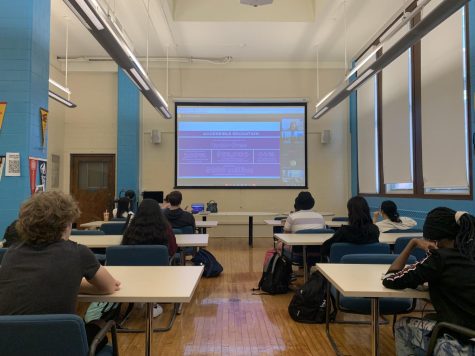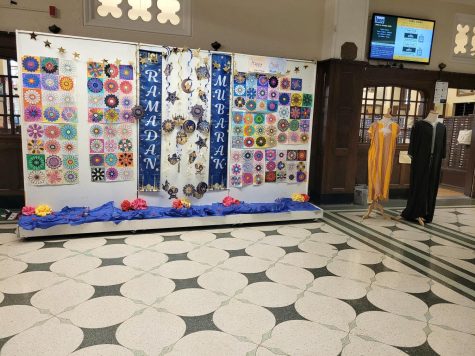Boys dominate Lane’s STEM classes: Where are the girls?
Ainslie Evans and Milo Lemoine work together in robotics class. Evans is the only girl in her group, and one out of only five girls in the class.
December 21, 2018
The first time Georgia Wolf walked into her first period Aerospace class, she stood amongst a sea of boys, watching the door in anticipation for another female face. The room sounded with laughter from her surrounding peers as they realized that she was the only girl in a class of 32 students.
“My face dropped, and all the guys started laughing,” Wolf, Div. 984, said. “I didn’t know if they were laughing at me or with me, or just at my expression. It was like an, ‘Are you kidding me?’ kind of thing.”
Wolf is not the only girl who has dealt with underrepresentation in classes. At Lane, boys generally dominate science, technology, engineering and math (STEM) related classes, especially computer science courses.
In Ms. Wozniak’s Innovation and Creation Lab, or “ICL” class, Wozniak said that there are only 5 girls in a class of 30.
According to Mr. Law, head of the Computer Science department, 63.50% of students who identify as male are presently enrolled in a computer science course, while only 23.26% of students who identify as female are enrolled.
Mr. Wilson, who teaches Aerospace, suggested that the reason for such a lack of girls in STEM classes might be due to a general trend in the girls’ lack of self confidence.
“It seems like with most of the male students, if they have a setback, they have the mentality of ‘I got this,’ they walk in there thinking they should get an A,” Wilson said. “Whereas most of my female students, even when they do a good airplane, or they get an A on a test, they believe they still suck somehow. They never can prove it to themselves that they’re good enough and I think that just wears them down. They become discouraged and they don’t want to do it.”
Wilson’s observation may hold true on a global scale.
In a study conducted in the research journal entitled “Sex Roles” by Swedish researchers Una Tellhed, Martin Bäckström, and Fredrik Björklund, girls and boys rated their self-efficacy in STEM subjects.
On average, girls had much lower self efficacy ratings in STEM than boys, despite performing better than them in certain tasks regarding the field.
The researchers explained that this might connected to the idea of “social belongingness,” the concept that teenagers feel more compelled to participate in activities where more of their gender is represented.
GEMS Club President Jessa Malicdem, Div. 952, said she believes that this division between girls and boys in STEM fields begins during childhood.
“I think from a young age, women don’t get the same encouragement that men do to pursue STEM careers,” Malicdem said. “Little things like toy cars and planes, chemistry sets, dinosaurs, building blocks, and more are all directed specifically towards boys, which encourages them to be more engaged in science and technology in school than girls.”
In 2016, however, a newly implemented change in curriculum made it a requirement for all students beginning with the Class of 2020 to take at least one computer science course before they graduate, thus forcing more girls to become exposed to the field.
For example, in Wozniak’s Media Computation class, Wozniak said that in years prior, the class
was typically more populated by boys. Now, the girls and boys in the class are about split since hers is an entry level class.
“That [the graduation requirement] is swaying the numbers,” Wozniak said. There’s more females taking the classes, but that’s because everybody has to take the classes.”
According to Law, the subject was made mandatory on the basis of a graduation requirement in order to teach students a specific set of abilities dubbed “computational thinking skills.”
“It’s this idea that you should be able to look at tasks or problems and be able to analyze the problem and then come up with a solution in a ordered and algorithmic way,” Law said. “We believe that CS still teaches students how to be creative, but it also teaches them those sort of skills that come easily within computer science.”
Nevertheless, Wozniak said that it is still a challenge to encourage more girls to continue their STEM education in the more advanced classes.
According to a 2016 study from the National Girls Collaborative Project, three percent of male students were more likely to take engineering at the high school level as opposed to only one percent females enrolled in such courses.
In AP Computer Science, 81 percent males were enrolled with only 19 percent females taking the course, the study said.
Wozniak explained that it is important for teachers to maintain a good relationship with female students in order to empower them in their STEM endeavors and encourage them to take higher level classes.
“Last year, I had a lot of girls that didn’t want to take the next class, but when I approached them and said ‘Hey, you seem to be doing really well in here; you’re good at this, they almost didn’t even really think of it that way,” Wozniak said. “And after I approached them, they were more inclined to want to take the class. You have to try to give a voice to the girls and make them feel like they can do it, they are welcome, and that they’re good at it.”
One way in which Lane encourages female students to become involved in the STEM field is through STEM-related clubs, such as GEMS club.
According to Malicdem, the aim of GEMS Club is to expose young women to the variety of careers in STEM.
“STEM encompasses so many different fields and is involved in the making of almost all of our everyday needs,” Malicdem said. “GEMS is dedicated to preparing young women to be leaders in these fields. It is a resource for our girls to help them learn more about what actions they can take right now in high school to prepare for their futures.”
Malicdem said that the club provides guest speakers and field trips related to STEM topics in order to help them find their passion.
“We motivate young women by introducing them to fields they may not have even known about before GEMS and by doing so in an engaging way,” Malicdem said. “Women who work in STEM careers come to Lane and explain what they do in their job, what challenges they have faced, and what advice they have for young women interested in the field.”
Technovation is another club that aids female students in STEM endeavors.
“Our club is basically a community of girls who join together and use computers to solve community problems,” Club President Dai Gianna Williams, Div. 179, said. “We go to the club, we identify a problem in our community — some other girls have come up with problems like recycling, environmental issues, electronic waste, and bullying — and they think of a way that an app can solve it or at least alleviate the problem.”
The club motivates girls to pursue STEM fields through teaching computer science as well as through scholarship opportunities.
Wozniak emphasized that now, more than ever, it is crucial for girls to become involved in STEM.
“All your phones, computers and high tech equipment are going to be produced by men,” Wozniak said. “Your apps, your software, your games — everything is created by men, so wouldn’t you rather have women creating games that appeal to women, or women creating apps that appeal to women?”
Malicdem expressed a similar sentiment on the future of girls in STEM, and recalled an anecdote from a speaker she heard at a conference for women in technology.
“She [the speaker] said that we want women in the room not because it’s the nice thing to do, but because we need women’s perspectives,” Malicdem said. “Who knows more about women’s health, statistics, preferences, and needs than actual women? Women make up more than half of the world’s population, so it’s only logical that they are equally represented in STEM fields that affect the world we live in.”








